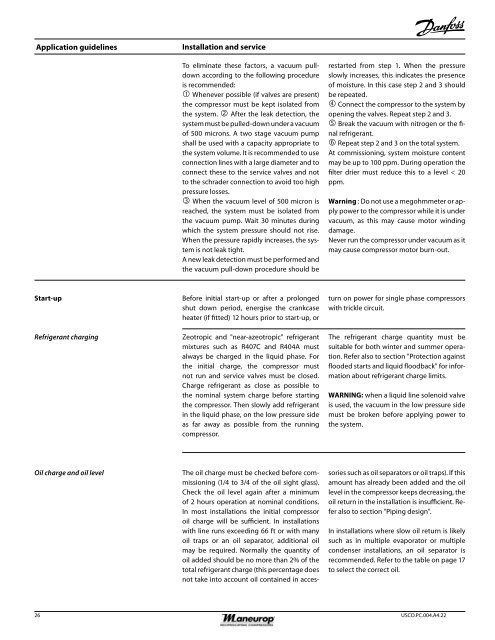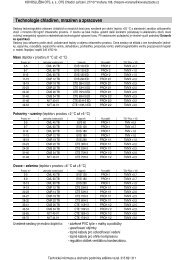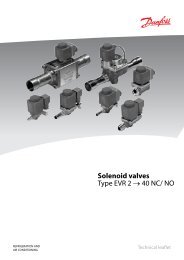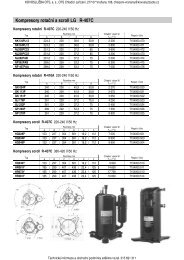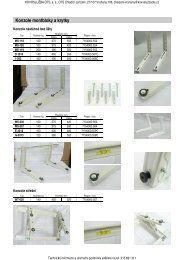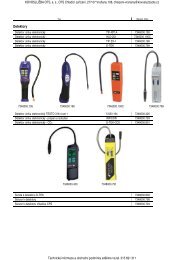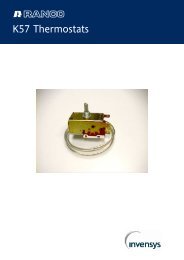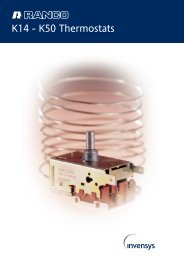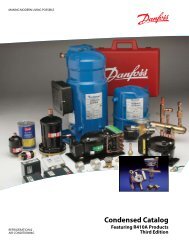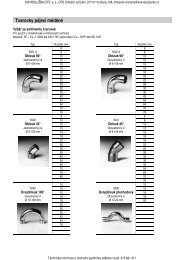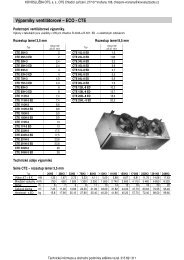Maneurop® reciprocating compressors
Maneurop® reciprocating compressors
Maneurop® reciprocating compressors
You also want an ePaper? Increase the reach of your titles
YUMPU automatically turns print PDFs into web optimized ePapers that Google loves.
Application guidelines<br />
Installation and service<br />
To eliminate these factors, a vacuum pulldown<br />
according to the following procedure<br />
is recommended:<br />
Whenever possible (if valves are present)<br />
the compressor must be kept isolated from<br />
the system. After the leak detection, the<br />
system must be pulled-down under a vacuum<br />
of 500 microns. A two stage vacuum pump<br />
shall be used with a capacity appropriate to<br />
the system volume. It is recommended to use<br />
connection lines with a large diameter and to<br />
connect these to the service valves and not<br />
to the schrader connection to avoid too high<br />
pressure losses.<br />
When the vacuum level of 500 micron is<br />
reached, the system must be isolated from<br />
the vacuum pump. Wait 30 minutes during<br />
which the system pressure should not rise.<br />
When the pressure rapidly increases, the system<br />
is not leak tight.<br />
A new leak detection must be performed and<br />
the vacuum pull-down procedure should be<br />
restarted from step 1. When the pressure<br />
slowly increases, this indicates the presence<br />
of moisture. In this case step 2 and 3 should<br />
be repeated.<br />
Connect the compressor to the system by<br />
opening the valves. Repeat step 2 and 3.<br />
Break the vacuum with nitrogen or the final<br />
refrigerant.<br />
Repeat step 2 and 3 on the total system.<br />
At commissioning, system moisture content<br />
may be up to 100 ppm. During operation the<br />
filter drier must reduce this to a level < 20<br />
ppm.<br />
Warning : Do not use a megohmmeter or apply<br />
power to the compressor while it is under<br />
vacuum, as this may cause motor winding<br />
damage.<br />
Never run the compressor under vacuum as it<br />
may cause compressor motor burn-out.<br />
Start-up<br />
Refrigerant charging<br />
Before initial start-up or after a prolonged<br />
shut down period, energise the crankcase<br />
heater (if fitted) 12 hours prior to start-up, or<br />
Zeotropic and "near-azeotropic" refrigerant<br />
mixtures such as R407C and R404A must<br />
always be charged in the liquid phase. For<br />
the initial charge, the compressor must<br />
not run and service valves must be closed.<br />
Charge refrigerant as close as possible to<br />
the nominal system charge before starting<br />
the compressor. Then slowly add refrigerant<br />
in the liquid phase, on the low pressure side<br />
as far away as possible from the running<br />
compressor.<br />
turn on power for single phase <strong>compressors</strong><br />
with trickle circuit.<br />
The refrigerant charge quantity must be<br />
suitable for both winter and summer operation.<br />
Refer also to section "Protection against<br />
flooded starts and liquid floodback" for information<br />
about refrigerant charge limits.<br />
WARNING: when a liquid line solenoid valve<br />
is used, the vacuum in the low pressure side<br />
must be broken before applying power to<br />
the system.<br />
Oil charge and oil level<br />
The oil charge must be checked before commissioning<br />
(1/4 to 3/4 of the oil sight glass).<br />
Check the oil level again after a minimum<br />
of 2 hours operation at nominal conditions.<br />
In most installations the initial compressor<br />
oil charge will be sufficient. In installations<br />
with line runs exceeding 66 ft or with many<br />
oil traps or an oil separator, additional oil<br />
may be required. Normally the quantity of<br />
oil added should be no more than 2% of the<br />
total refrigerant charge (this percentage does<br />
not take into account oil contained in accessories<br />
such as oil separators or oil traps). If this<br />
amount has already been added and the oil<br />
level in the compressor keeps decreasing, the<br />
oil return in the installation is insufficient. Refer<br />
also to section "Piping design".<br />
In installations where slow oil return is likely<br />
such as in multiple evaporator or multiple<br />
condenser installations, an oil separator is<br />
recommended. Refer to the table on page 17<br />
to select the correct oil.<br />
26 USCO.PC.004.A4.22


